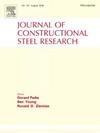Seismic performance of PS-CFST bridge piers with novel external replaceable energy dissipating devices
IF 4
2区 工程技术
Q1 CONSTRUCTION & BUILDING TECHNOLOGY
引用次数: 0
Abstract
This study proposed a novel external replaceable energy-dissipating device (EREDD) to enhance the seismic performance of prefabricated segmental concrete filled steel tubular bridge piers (PS-CFST bridge piers), while maintaining the construction efficiency of conventional segmentally assembled prefabricated piers with dry joints. The effectiveness and applicability of EREDDs in improving the seismic performance of PS-CFST bridge piers were studied through the cyclic tests. The inelastic cyclic response of PS-CFST bridge pier specimens with different arrangements of EREDDs was experimentally examined. A detailed account of the test results was provided and discussed, including the stiffness and strength characteristics, strain distributions, residual displacements, failure patterns, as well as hysteretic response and energy dissipation capability. Particular attention was also given within the experimental assessment to investigating the effects of the inter-segmental joint opening positions for the different EREDD arrangements on the seismic response of PS-CFST bridge piers. Based on the experimental findings, an analytical approach was developed for determining the hysteretic response of the proposed PS-CFST bridge piers incorporating EREDDs, offering the basis for their design and assessment in practice. Finally, the results indicate that EREDDs could effectively improve the seismic performance of PS-CFST bridge piers and the hysteretic response could be accurately predicted by using the proposed analytical approach. In addition, EREDDs allow the damage of PS-CFST bridge piers to be concentrated within the easily replaceable component, and thereby facilitating the controlled damage. This study provides an effective method for the seismic design of PS-CFST bridge piers incorporating EREDDs.
带有新型外部可更换消能装置的 PS-CFST 桥墩的抗震性能
本研究提出了一种新型外部可更换消能装置(EREDD),以提高预制节段混凝土填充钢管桥墩(PS-CFST 桥墩)的抗震性能,同时保持传统干接缝节段拼装预制桥墩的施工效率。通过循环试验研究了 EREDD 在改善 PS-CFST 桥墩抗震性能方面的有效性和适用性。实验检验了采用不同排列方式的 EREDD 的 PS-CFST 桥墩试件的非弹性周期响应。对试验结果进行了详细说明和讨论,包括刚度和强度特性、应变分布、残余位移、破坏模式以及滞后响应和耗能能力。在实验评估中,还特别关注了不同 EREDD 排列的分段连接开口位置对 PS-CFST 桥墩地震响应的影响。根据实验结果,开发了一种分析方法,用于确定包含 EREDD 的 PS-CFST 桥墩的滞回响应,为实际设计和评估提供依据。最后,研究结果表明,EREDDs 可以有效改善 PS-CFST 桥墩的抗震性能,并且可以通过所提出的分析方法准确预测滞回响应。此外,EREDD 还能使 PS-CFST 桥墩的损伤集中在易于更换的部件内,从而有利于控制损伤。本研究为采用 EREDD 的 PS-CFST 桥墩的抗震设计提供了一种有效的方法。
本文章由计算机程序翻译,如有差异,请以英文原文为准。
求助全文
约1分钟内获得全文
求助全文
来源期刊

Journal of Constructional Steel Research
工程技术-工程:土木
CiteScore
7.90
自引率
19.50%
发文量
550
审稿时长
46 days
期刊介绍:
The Journal of Constructional Steel Research provides an international forum for the presentation and discussion of the latest developments in structural steel research and their applications. It is aimed not only at researchers but also at those likely to be most affected by research results, i.e. designers and fabricators. Original papers of a high standard dealing with all aspects of steel research including theoretical and experimental research on elements, assemblages, connection and material properties are considered for publication.
 求助内容:
求助内容: 应助结果提醒方式:
应助结果提醒方式:


